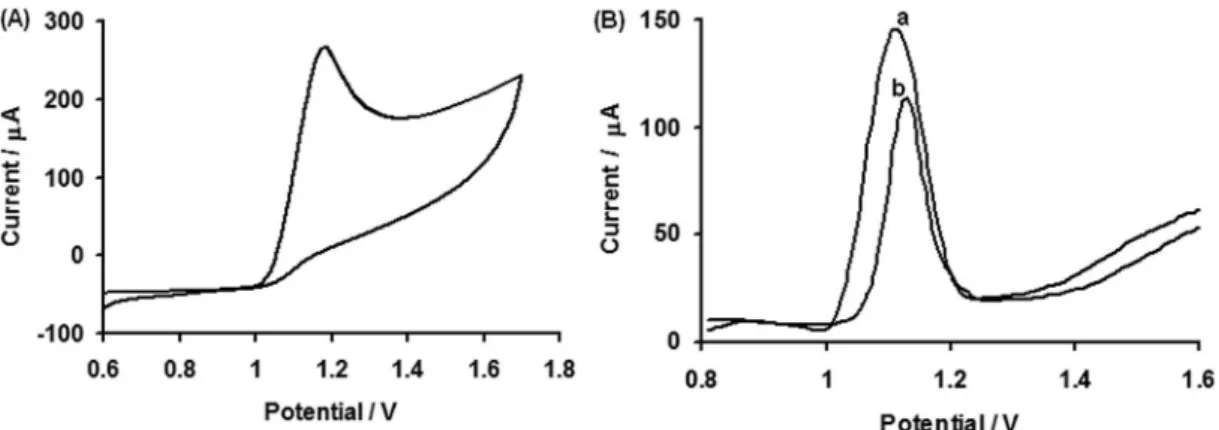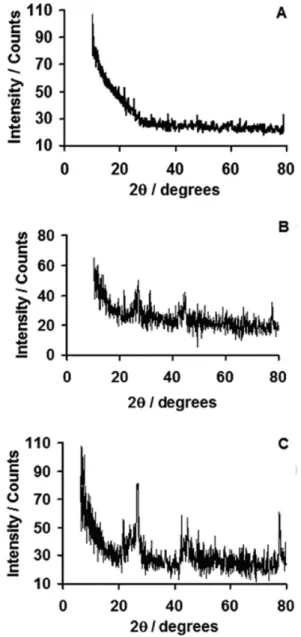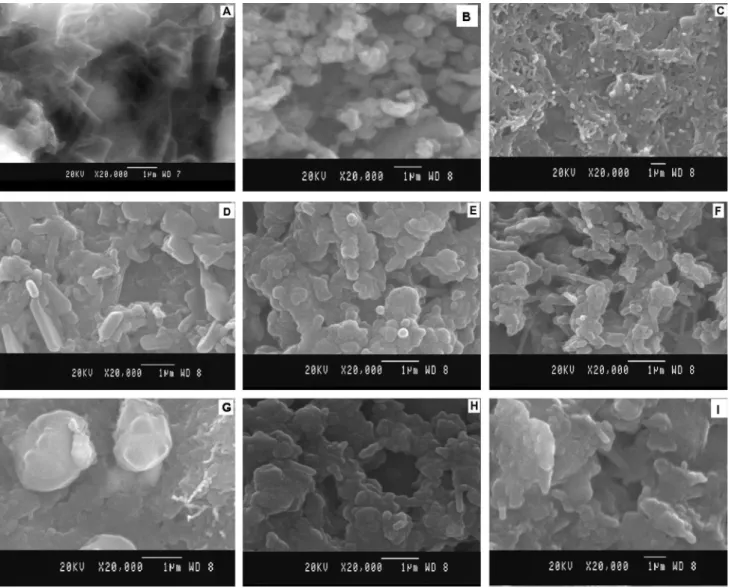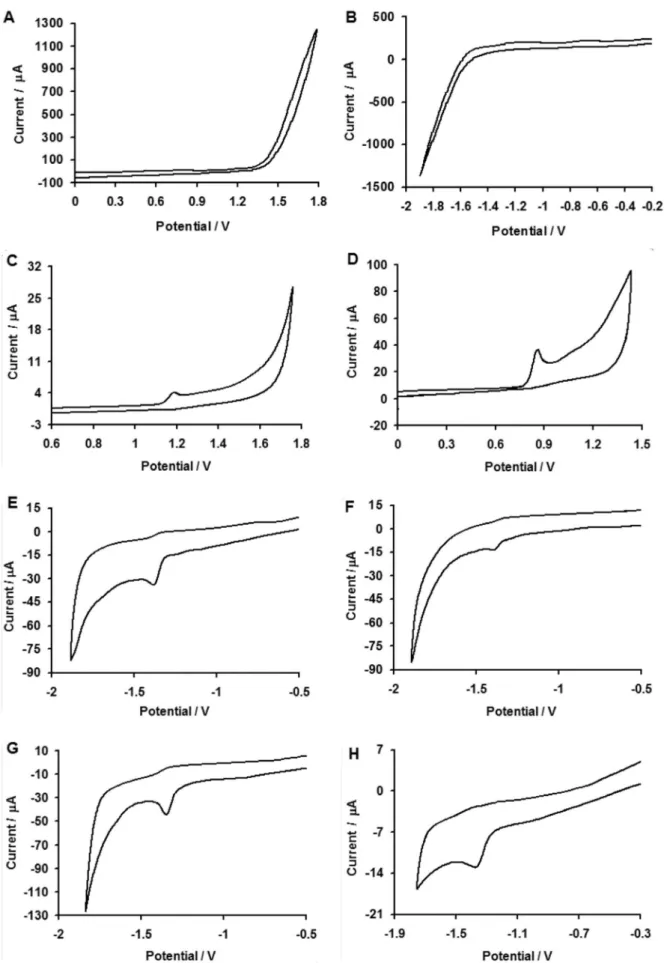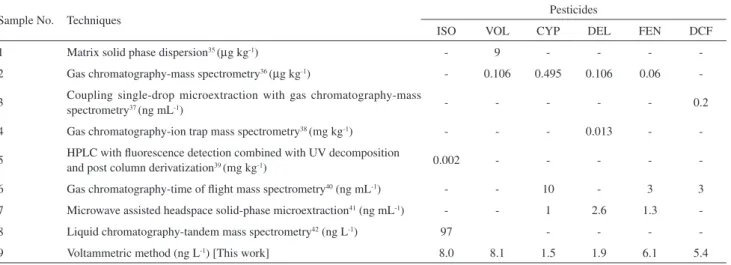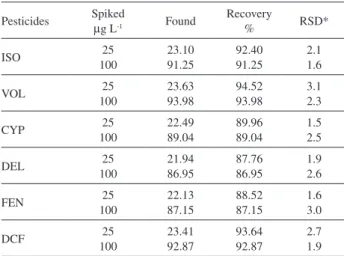Article
J. Braz. Chem. Soc., Vol. 22, No. 4, 746-755, 2011. Printed in Brazil - ©2011 Sociedade Brasileira de Química 0103 - 5053 $6.00+0.00
A
*e-mail: pms11@rediffmail.com
Development of Nano Poly(3-methyl thiophene)/Multiwalled Carbon Nanotubes
Sensor for the Eficient Detection of Some Pesticides
Palaniappan Abirama Sundari and Paramasivam Manisankar*
Research Scholar, Department of Industrial Chemistry, School of Chemistry, Alagappa University, Karaikudi 630 003 Tamil Nadu, India
Foi construído um eletrodo baseado em eletrodo de carbono vítreo modiicado por um ilme de nanotubos de carbono de paredes múltiplas ((MWCNTs)/poli(3-metil tiofeno, P3MT), que foi usado na determinação diferentes classes de pesticidas por voltametria de redissolução de onda quadrada. Inclui-se herbicidas (isoproturon), inseticidas (voltage, cipermetrina, deltametrina, fenvalerato), e acaricidas (dicofol). O comportamento eletroquímico dos pesticidas selecionados foi investigado na superfície do nanocomposito P3MT/MWCNT/GCE, em pH 1, 4, 7, 9,2 e 13. Os voltamogramas cíclicos do isoproturon (ISO) e voltage (VOL) exibiram picos de oxidação bem deinidos em pH 1, enquanto os outros exibiram pico de redução em pH 13. A determinação por voltametria de redissolução de onda quadrada dos pesticidas acima citados foi desenvolvida no mesmo sistema modiicado e baixos limites de detecção foram obtidos. O procedimento analítico proposto foi aplicado em águas naturais aditivadas com os pesticidas selecionados para validar o procedimento desenvolvido.
A modiied electrode fabricated by coating multiwalled carbon nanotubes (MWCNTs)/poly(3-methyl thiophene, P3MT) ilm on a glassy carbon electrode (GCE) and was used for the adsorptive stripping voltammetric determination of different classes of pesticides. These include herbicide (isoproturon), insecticides (voltage, cypermethrin, deltamethrin, fenvalerate) and an acaricide (dicofol). Electrochemical behaviour of all the selected pesticides was investigated on P3MT/ MWCNT/GCE nano composite surface at selected pHs 1, 4, 7, 9.2 and 13. In cyclic voltammetry, isoproturon (ISO) and voltage (VOL) exhibited one well-deined oxidation peak at pH 1, while remaining pesticides gave one reduction peak at pH 13. Adsorptive stripping voltammetric determination of above-said pesticides was developed on the same modiied system and lowest detection limits were achieved. The proposed analytical procedure was applied to natural water samples spiked with the selected pesticides to validate the developed stripping procedure.
Keywords: nano sensor, poly(3-methyl thiophene), herbicide, insecticide, acaricide
Introduction
Since the discovery of carbon nanotubes (CNTs) in 1991,1 they have been considered one of the most
promising materials for various applications. In recent years, CNTs have been applied in various ields such as energy storage,2 actuators,3 and sensors.4 Especially,
it opens a new door for electroanalytical chemistry ield because of its large speciic surface area and good capability of electron transfer. It has been reported that CNTs modiied electrodes were successfully applied to determine many biological and organic molecules such as ascorbic acid and uric acid,5 NADH,6 amino acids,7 rutin,8,9
hydrazine,10 H 2O2,
11 adenine, and guanine.12,13 In recent
years, conducting polymer/CNTs-modiied electrodes have been of great interest in electrocatalysis reactions because of their unique chemical and electrochemical properties. It has also been demonstrated that the incorporation of CNTs into conducting polymer-modified electrode possess the properties of individual components with a synergistic effect that would be useful for numerous applications.14-21 Among the conducting polymers known
P3MT and MWCNTs for the effective determination of dopamine,31 and some biologically important compounds
like NADH, FAD and cytochrome c.32
Environmental pollution is a serious concern in recent times due to the damage of eco system in the globe. Among the pollutants, pesticides are considered as hazardous chemicals used in agriculture. Pesticide is a substance used to kill or repel insects, weeds, bacteria, mold, or viruses. The use of pesticide raises a number of environmental concerns. Over 98% of sprayed insecticides and 95% of herbicides reach a destination other than their target species, including air, water, bottom sediments and food.33 They cause
water pollution and some are persistent and contribute to soil contamination. In addition, pesticide use also reduces biodiversity and results in lower soil quality, reduced nitrogen ixation, contribute to pollinator decline, can reduce habitat, especially for birds, and can threaten endangered species. Several environmental and health problems are associated with their use. Hence the determination of pesticides in trace level becomes very important in environmental point of view. In the present work, a new P3MT/MWCNTGCE nano pesticide sensor was fabricated for the quantiication of some important pesticides, isoproturon (ISO), voltage (VOL), cypermethrin (CYP), deltamethrin (DEL), fenvalerate (FEN) and dicofol (DCF).
Experimental
Instrumentation and reagents
Cyclic and differential pulse stripping voltammetric studies were performed using CHI 760C electrochemical workstation (CH Instruments, USA) coupled with a conventional three-electrode cell. The working electrode was P3MT/MWCNT/GCE, the auxiliary electrode was platinum wire and the reference electrode was Ag/AgCl. MWCNTs (I.D. × length 2-15 nm × 1-10 µm, produced by arc method) purchased from Sigma-Aldrich, USA and the dispersive agent sodium dodecyl sulphate (SDS) (AR Grade) was purchased from Merck, India. Technical grade of all the selected pesticides were obtained from the Bureau of Indian Standards. 0.1 mol L-1 stock solution was made
up in ethanol for all these pesticides. For studies in aqueous media, 0.1 mol L-1 H
2SO4 (for pH 1.0), Britton Robinson
Buffers (for pH 4.0, 7.0, 9.2) and 0.1 mol L-1 NaOH (for
pH 13.0) in 50% aqueous alcohol were used. Bench top pH meter model-Cyberscan 500 (Eutech Instrument) was used for all pH measurements.
reported by us earlier.34 First, 1 mg of MWCNTs was dispersed
into 0.1 mol L-1 SDS for 30 min by ultrasonic agitation to
give a homogeneous MWCNTs suspension. Secondly, GCE surface was coated with 5 µL of the resulting MWCNT-SDS
suspension and allowed to evaporate in an oven at 50 °C. P3MT was deposited by electrooxidation of 0.05 mol L-1
3-methyl thiophene (3MT) containing 0.05 mol L-1 sodium
perchlorate as a supporting electrolyte and cycling the potential between 0 V and 1.6 V on MWCNT/GCE.
Real sample analysis
In order to assess the possible applications of the proposed method in the determination of pesticides, samples were spiked with water and then analyzed using the following procedure. The water sample to be analyzed was prepared by adding known amount of ISO stock solution and pesticide-free water and then allowing them to stand 24 h. A glass column was illed with amberlite XAD-4 resin up to a height of 20 cm. The column was washed with ethanol, diethyl ether and distilled water. Then the spiked water was iltered through the column at an average rate of 10 mL min-1. After completion of this process, the tap
was closed and dichloromethane illed the column and then allowing them to stand 20 min. Thus, the column was drained into a beaker. The extract was evaporated to dryness by gentle heating on a water bath. The residue was transferred into a 250 mL calibrated lask, dissolved in ethanol and made up to the mark. ISO was determined by differential pulse stripping voltammetric method. Percentage of recovery and relative standard deviations for ISO were determined for six different concentrations. Similar experiments were carried out for the other pesticides and the results are discussed in the following section
Results and Discussion
Voltammetric behaviour of pesticides
The catalytic activity of modified electrode is demonstrated in the cyclic voltammograms (CVs) recorded for all the selected pesticides in the pH range of 1 to 13. When the electrode potential was scanned from 0.6 to 1.7 V for ISO (0.99 m mol L-1) and 0 to 1.3 for VOL
(0.99 mmol L-1), a well-deined oxidation peak at 1.183 V,
(291.5 µA) for the former and 0.856 V, (301.9 µA) for the
later in 0.1 mol L-1 H
2SO4 (pH 1) at the scan rate of 0.1 V s -1
Absence of cathodic peaks in the reverse scan of both the cases indicated irreversible nature of electron transfer process. The electrochemical responses of 1 mmol L-1 CYP,
DEL, FEN and 0.99 mmol L-1 DCF in 0.1 mol L-1 NaOH at
the same modiied electrode were investigated. Figures 3A to 6A show the cyclic voltammograms of CYP, DEL, FEN and DCF at pH 13 at the scan rate of 0.1 V s-1. One reduction
peak at −1.381 V (312.9 µA), −1.38 V (306.1 µA), −1.348 V
(320.6) and −1.324 V (339.2 µA) were observed for CYP,
DEL, FEN and DCF, respectively. On the reversal scan, no oxidation peak appears, indicating the complete irreversible reduction of above pollutants.
Further, the effect of scan rate on the electrooxidation and reduction of selected pesticides at the modified electrode was investigated by cyclic voltammetry. Correlation of peak current (iP) with sweep rate (ν) and
square root of sweep rate (ν1/2) resulted that the peak
current increases linearly with ν up to ν < 0.150 V s-1,
Figure 1. (A) Cyclic voltammogram of 0.99 mmol L-1 ISO, scan rate 0.1 V s-1; (B)Differential pulse stripping voltammogram of 100 µg L-1 ISO
(a) conventional (b) real sample at pH 1.
Figure 2. (A) Cyclic voltammogram of 0.99 mmol L-1 VOL, scan rate 0.1 V s-1; (B) Differential pulse stripping voltammogram of 100 µg L-1 VOL
(a) conventional (b) real sample at pH 1.
Figure 3. (A) Cyclic voltammogram of 1 mmol L-1 CYP, scan rate 0.1 V s-1; (B)Differential pulse stripping voltammogram of 100 µg L-1 CYP (a) conventional
while at higher scan rates a linear dependence of peak currents on ν1/2 is observed with the straight line having
good correlation coeficient (0.98 to 0.99). The plot of log iPvs. log ν correlation equation also led to a straight
line (with a slope value of 0.54 to 0.62). All the above facts conirmed diffusion controlled adsorption nature of above said redox processes. Furthermore, fractional α value (0.47
to 0.78) indicated, irreversible electron transfer nature for the above process. The signiicant improvement of peak
current together with the sharpness of anodic and cathodic peaks clearly demonstrate that the modiied ilm acts as an eficient electron transfer mediator in the electrocatalytic oxidation and reduction of aforementioned pesticides, leading to a considerable improvement in the analytical sensitivity. Table 1 exhibited peak currents obtained in different modiied systems by cyclic voltammetric method. From that table, it can be inferred that the peak current obtained in MWCNT/GCE and P3MT/GCE systems is very
Figure 4. (A) Cyclic voltammogram of 1 mmol L-1 DEL, scan rate 0.1 V s-1; (B)Differential pulse stripping voltammogram of 100 µg L-1 DEL (a) conventional
(b) real sample at pH 13.
Figure 5. (A) Cyclic voltammogram of 1 mmol L-1 FEN, scan rate 0.1 V s-1; (B)Differential pulse stripping voltammogram of 100 µg L-1 FEN (a) conventional
(b) real sample at pH 13.
Figure 6. (A) Cyclic voltammogram of 0.99 mmol L-1 DCF, scan rate 0.1 V s-1; (B)Differential pulse stripping voltammogram of 100 µg L-1 DCF
low compared to P3MT/MWCNT/GCE. This is because of synergistic effect between both the individual components, which greatly increases the peak current of all the selected pesticides.
Optimization of experimental conditions
Differential pulse stripping voltammetry was used in the voltammetric measurement owing to its good sensitivity and resolving power. The experimental conditions were optimized.
Inluence of accumulation parameters
It has been mentioned that the oxidation and reduction processes of all pesticides at the modiied electrode was an adsorption process which is controlled by diffusion, and hence pesticides might be accumulated on electrode surface through hydrophobic interaction between the pesticides and the surfactant layer. Thus, the inluence of accumulation time on peak currents of pesticides should be non-negligible. Peak current increases apparently with the increase of accumulation time. After a series of stripping voltammograms, 10 s for ISO, VOL and FEN, 5 s for CYP, DEL and DCF was chosen as the optimal accumulation time. The dependence of accumulation potential was also studied. It was varied from −0.3 to 0.3 V for all the selected pesticides
and best accumulation potential was found to be 0.2, 0.1,
−0.1, −0.15, 0.1 and 0 V for ISO, VOL, CYP, DEL, FEN and
DCF, respectively. These values showed that the adsorbed species are most probably neutral molecules of pesticides.
Characterization of modiied electrode
X-ray diffraction studies
XRD pattern of MWCNT/GCE is provided in Figure 7A that shows substantial amorphous nature and that of P3MT/ GCE (Figure 7B) exhibits also an amorphous nature. Figure 7C explains XRD pattern of P3MT/MWCNT/GCE,
Table 1. Comparison of cyclic voltammetric results at different modiied systems at the scan rate of 0.1 V s-1
Pesticides Concentration, mmol L-1
P3MT/GCE MWCNT/GCE P3MT/MWCNT/GCE
EP (V) iP (µA) EP (V) iP (µA) EP (V) iP (µA)
ISO 0.99 1.218 23.36 1.090 25.25 1.183 291.5
VOL 0.99 0.861 11.85 0.825 12.34 0.856 301.9
CYP 0.99 −1.415 49.72 −1.440 56.30 −1.381 312.9
DEL 1 −1.407 14.93 −1.490 16.00 −1.380 306.1
FEN 1 −1.370 14.01 −1.440 15.36 −1.348 320.6
DCF 1 −1.354 20.40 −1.398 23.71 −1.324 339.2
Figure 7. X-ray diffraction patterns of (A) MWCNT/GCE; (B) P3MT/ GCE; (C) P3MT/MWCNT/GCE.
MWCNT modiied ilm showed tubular morphology and that of P3MT modiied ilm showed uniformly distributed spherical shaped particulates. Figure 8C, showed polymer molecules deposited on the surface of tubes afirmed the polymerization of P3MT on MWCNTs. Interestingly, the SEM image of P3MT/MWCNT modiied ilm shows spherical shaped polymers reinforced into the MWCNTs. This observation suggests the formation of polymer embedded MWCNT nanocomposite structures on the electrode surface.The average tube size of the modiied surface was approximated 50 nm.
Adsorption of pesticides molecules was done at their maximum accumulation conditions owing to the diffusion controlled adsorption nature of pesticide molecules. The change in surface morphology was understood through
electrode surface is well evident from Figure 8D. Uniform adsorption of VOL could be seen from Figure 8E. Dense, mixed needle like structure in Figure 8F exhibits CYP adsorbed modiied surface. Figure 8G shows ball like particles dispersed in a random manner that conirms the presence of DEL on the modiied system. Figure 8H indicates cloudy like appearance conirming the adsorption process of FEN. DCF molecules are adsorbed uniformly as lakes on the surface of modiied system as displayed in Figure 8I.
Figures 9 show cyclic voltammograms obtained at the modiied surface before and after adsorption. From this, one can ind, there is no response in the cyclic voltammograms in buffer solutions 1 and 13 alone, i.e., in the absence of pesticide molecules (Figures 9A and B). But after 10 min
Table 2. Comparison limits of detection (LOD) with available methods
Sample No. Techniques Pesticides
ISO VOL CYP DEL FEN DCF
1 Matrix solid phase dispersion35 (µg kg-1) - 9 - - -
-2 Gas chromatography-mass spectrometry36 (µg kg-1) - 0.106 0.495 0.106 0.06
-3 Coupling single-drop microextraction with gas chromatography-mass
spectrometry37 (ng mL-1) - - - 0.2
4 Gas chromatography-ion trap mass spectrometry38 (mg kg-1) - - - 0.013 -
-5 HPLC with luorescence detection combined with UV decomposition
and post column derivatization39 (mg kg-1) 0.002 - - - -
-6 Gas chromatography-time of light mass spectrometry40 (ng mL-1) - - 10 - 3 3
7 Microwave assisted headspace solid-phase microextraction41 (ng mL-1) - - 1 2.6 1.3
-8 Liquid chromatography-tandem mass spectrometry42 (ng L-1) 97 - - -
-9 Voltammetric method (ng L-1) [This work] 8.0 8.1 1.5 1.9 6.1 5.4
Inluence of stripping parameters
Analytical signal for all the selected pesticides were optimized by changing the following parameters, initial scan potential, amplitude, pulse width, and keeping other parameters such as scan increment, sampling width, pulse period and quiet time, constant. Adsorptive stripping voltammetry enhances the scope of stripping measurements towards numerous trace analysis. Depending on the redox activity of compound, the quantification of adsorbed organic analyte may either proceed through oxidation or reduction. Initial scan potential was changed from 0 to 0.9 V for ISO, 0 to 0.6 for VOL, −0.5 V to −1.0 V for
CYP and DCF, −0.5 to −1.2 V for DEL and FEN. Peak
current response was found to be maximum in the range of 0.8, 0.5 for ISO and VOL, −0.8 for CYP and FEN, −1.0
for DEL and DCF respectively. For pulse amplitude study between 0.010 and 0.2 V, linear relationship was noticed between peak current and applied pulse amplitudes from 0.010 to 0.090 V. Hence pulse amplitude of 0.090 V was chosen further due to the maximum current response in the linear range. Effect of pulse width has demonstrated that the stripping peak current was observed to decrease with increasing pulse width from 0.010 to 0.150 s and maximum of the peak current was reached in the pulse width of 0.05 s for all the reported pesticides.
Analytical determination of pesticides
Calibration plot
Under optimized conditions, differential pulse stripping voltammograms of all the above said pesticides are shown
25×104 ng L-1 for FEN, 5.4 to 25×104 ng L-1 for DCF. The
minimum concentration value (detection limit) reported here is lower than other chromatographic methods. The analytical characteristics observed during the validation of this method were then compared with those obtained in earlier reports (Table 2).
Validation of the method
Validation of the proposed method for the quantitative estimation of pesticides was examined via evaluation of the speciicity, stability and precision of the method as follows.
Speciicity
Speciicity of optimized procedure for the evaluation of pesticides was investigated by observing any interference encountered from endogenous substances present in it, which may affect the speciicity of proposed method. Tolerance limit was defined as the concentrations of foreign substances, which gave an error less than ± 5.0% in the detection of pesticides. The effect of interferences (anions such as Cl−, Br− , I−, SO
4 2−, NO
3
−was examined
by carrying out the determination of 250 µg L-1 in the
presence of different concentrations (150-300 µg L-1)of
the interferences.
Stability and reproducibility of the modiied electrode
the determination of all pesticides. Precision of this method was evaluated by repeating six experiments for six consecutive days for same concentration of pesticide solution. Relative standard deviation value was found to be 2.08%. The electrode-to-electrode reproducibility of this method was examined on six modiied electrodes fabricated individually and R.S.D. of the four average peak currents of 0.1 mmol L-1 of pesticide was calculated to be 1.92%,
which demonstrates good reproducibility of present method at this electrode.
Analytical applications
Recovery studies in real samples
We examined the applicability of modiied electrode for the determination of pesticides in water samples. The recoveries indicate that, the accuracy of the proposed voltammetric method is good. Precision and accuracy of this method was determined after dosing known amount of analytes into environmental sample solution. The precision of all pollutants was calculated from six repeated analyses at different intervals. The percentage of recoveries with standard error of all the insecticides is presented in Table 3. The stripping voltammograms thus obtained are given in Figures 1B(b)-6B(b) on the same system. Based on this study, it is possible to conclude that these stripping voltammetric measurements are eficient in the determination of all type pesticides.
Conclusions
Glassy carbon electrode modiied with P3MT/MWCNT ilm has been used successfully for the electrocatalytic oxidation and reduction of some pesticides in acidic
and alkaline solutions. The obtained modified film exhibits individual properties of both the constituents,
i.e., conducting polymer and MWCNTs. Herein, 3MT polymerizes on the fine matrix of MWCNTs and the same was confirmed through SEM micrographs. The results indicate that the modified electrode facilitates the determination of pesticides with good sensitivity and reproducibility compared to similar conducting polymer/ MWCNT based electrodes or other instrumental methods. This sensor can be used for the stripping voltammetric determination of selected analytes as low as 1.5-8.1 ng L-1
with good reproducibility with little fouling effects of analytes. This modiied electrode has been used for the determination of all the above said pesticides in spiked water samples. Our observations demonstrate that this conducting polymer/MWCNT modified electrode is a stable and reproducible with high sensitivity as well as lower detection limit, which could have promising applications in sensor. The same method offers the advantages of accuracy and time saving as well as simplicity of reagents and apparatus. In addition, the results obtained in the analysis of pesticides in water samples demonstrate that, the applicability of this method for real sample analysis. In general the proposed stripping voltammetric method is sensitive than majority of the available methods.
Acknowledgements
The authors would like to thank Department of Science and Technology (DST), New Delhi, India for their inancial support to our project (Vide Project No. SR/S1/PC-16/2005 dt. 26.09.2007) and Dr. P. Manisankar wishes to thank UGC for providing inancial assistance to Department of Industrial Chemistry.
References
1. Iijima, S.; Nature1991, 354, 56.
2. Lin, K.; Xu, Y.; He, G.; Wang, X.; Mater. Chem. Phys. 2006, 99, 190.
3. Baughman, R. H.; Cui, C.; Zakhidov, A. A.; Iqbal, Z.; Barisci, J. N.; Spinks, G. M.; Wallace, G. G.; Mazzoldi, A.; Rossi, D. D.; Rinzler, A. G.; Jaschinski, O.; Roth, S.; Kertesz, M.; Science
1999, 284, 1340.
4. Wei, C.; Dai, L.; Roy, A.; Tolle, T. B.; J. Am. Chem. Soc.2006, 128, 1412.
5. Yogeswaran, U.; Thiagarajan, S.; Chen, S. M.; Anal. Biochem.
2007, 365, 122.
6. Zeng, J. X.; Gao, X. H.; Wei, W. Z.; Zhai, X. R.; Yin, J.; Wu, L.; Liu, X. Y.; Liu, K.; Gong, S. G.; Sens. Actuators B2007, 120, 595.
Table 3. Percentage recovery of selected pesticides from water samples
Pesticides Spiked
µg L-1 Found
B2006, 115, 240.
9. Wang, G. F.; Hu, N. J.; Wang, W.; Li, P. C.; Gu, H. C.; Fang, B.; Electroanalysis2007, 19, 2329.
10. Zhao, Y. D.; Zhang, W. D.; Chen, H.; Luo, Q. M.; Talanta2002, 58, 529.
11. Wang, S. G.; Zhang, Q.; Wang, R.; Yoon, S. F.; Ahn, J.; Yang, D. J.; Tian, J. Z.; Li, J. Q.; Zhou, Q.; Electrochem. Commun.
2003, 5, 800.
12. Wang, Z. H.; Xiao, S. F.; Chen, Y.; J. Electroanal. Chem.2006, 589, 237.
13. Li, Q. W.; Zhang, J.; Yan, H.; He, M. S.; Liu, Z. F.; Carbon
2004, 42, 287.
14. Sandler, J.; Shaffer, M. S. P.; Prasse, T.; Bauhofer, W.; Schulte, K.; Winder, A. H.; Polymer1999, 40, 5967.
15. Wang, Z. J.; Yuan, J. H.; Li, M. Y.; Han, D. X.; Zhang, Y. J.; Shen, Y. F.; Niu, L.; Ivaska, A.; J. Electroanal. Chem.2007, 599, 121.
16. Wang, J.; Musameh, M.; Anal. Chim. Acta2005, 539, 209. 17. Tsai, Y. C.; Li, S. C.; Liao, S. W.; Biosens. Bioelectron.2006,
22, 495.
18. San, S. E.; Yerli, Y.; Okutan, M.; Yilmaz, F.; Gunaydin, O.; Hames, Y.; Mater. Sci. Eng.B2007, 138, 284.
19. Guo, M. L.; Chen, J. H.; Li, J.; Tao, B.; Yao, S. Z.; Anal. Chim. Acta2005, 532, 71.
20. Gao, M.; Huang, S.; Dai, L.; Wallace, G.; Gao, R.; Wang, Z.; Angew. Chem. Int. Ed. Engl.2000, 39, 3664.
21. Coleman, J. N.; Curran, S.; Dalton, A. B.; Davey, A. P.; McCarthy, B.; Blau, W.; Barklie, R. C.; Synth. Met.1999, 102, 1174.
22. Wang, J.; Li, R.; Anal. Chem.1989,61, 2809.
23. Agui, L.; Serra, B.; Yanez-Sedeno, P.; Reviejo, A. J.; Pingarron, J. M.; Electroanalysis 2001, 13, 1231.
24. Mark Jr, H. B.; Atta, N.; Ma, Y. L.; Petticrew, K. L.; Zimmer, H.; Shi, Y.; Lunsford, S. K.; Rubinson, J. F.; Galal, A.; Bioelectrochem. Bioenerg.1995,38,229.
27. Wang, H. S.; Huang, D. Q.; Liu, R. M.; J. Electroanal. Chem.
2004,570, 83.
28. Augi, L.; Gonzalez-Cortes, A.; Yanez-Sedeno, P.; Pingarron, J. M.; Anal. Chim. Acta1999,401, 145.
29. Jaraba, P.; Augi, L.; Yanez-Sedeno, P.; Pingarron, J. M.; Electrochim. Acta1998,43, 3555.
30. Armentia, C. L.; Sampedro, C.; Goicolea, M. A.; Balugera, Z. G.; Rodriguez, E.; Barrio, R. J.; Electroanalysis1999,11, 1222. 31. Wang, H-S.; Li, T-H.; Jia, W-L.; Xu, H-Y.; Biosens. Bioelectron.
2006,22, 664.
32. Augi, L.; Pena-farfal, C.; Yanez-Sedeno, P.; Pingarron, J. M.; Electrochim. Acta2007,52, 7946.
33. Miller, G. T.; Sustaining the Earth, 6th edition, Thompson Learning, Inc. Paciic Grove, California. 2004, 211.
34. Manisankar, P.; Viswanathan, S.; Mercy Pusphalatha, A.; Rani, C.; Anal. Chim. Acta2005,528, 157.
35. Chu, X -G.; Hu, X -Z.; Yao, H -Y.; J. Chromatogr. A2005,1063, 201.
36. Huang, Z.; Li, Y.; Chen, B.; Yao, S.; J. Chromatogr. B2007, 853, 154.
37. Zhang, M.; Huang, J.; Wei, C.; Yu, B.; Yang, X.; Chen, X.; Talanta2008,74, 599.
38. Gonzalez-Rodrıguez, R. M.; Rial-Otero, R.; Cancho-Grande, B.; Simal-Gandara,J.; J. Chromatogr. A2008,1196, 100. 39. Mou, R-X.; Chen, M-X.; Zhi, J-L.; J. Chromatogr. B2008,875,
437.
40. Patil, S. H.; Banerjee, K.; Dasgupta, S.; Oulkar, D. P.; Patil, S. B.; Jadhav, M. R.; Savant, R. H.; Adsule, P. G.; Deshmukh, M. B.; J. Chromatogr. A2009, 1216, 2307.
41. Li, H-P.; Lin, C-H.; Jen, J-F.; Talanta2009,79, 466.
42. Dagnaca, T.; Garcia-Chao, M.; Pulleiro, P.; Garcia-Jares, C.; Llompart, M.; J. Chromatogr. A2009,1216, 3702.
Submitted: January 4, 2010
